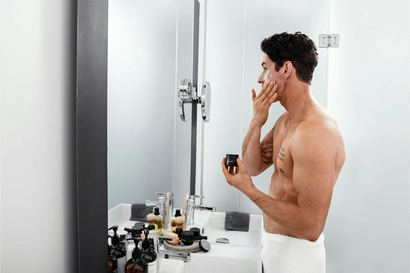

Words: Zoe Dickens
It started earlier than you thought. Probably somewhere in your early to mid-twenties. That widow’s peak started looking a little more prominent. That tell-tale M-shaped hairline started to show. No matter, you thought, I can just grow the top a bit longer to cover it up. Become one of those hipster types with a short fade and artfully sculpted mane.
But now you’re the wrong side of 30 and working a Big Four job in the city. That indie haircut looks a little ridiculous with your made-to-measure suit but you can’t bear to find out what lies beneath. Well, if it’s any consolation, you’re not alone. Nearly 80% of men will have a receding hairline by the time they reach the age of 80 and, while some experience it earlier than others, it is merely a natural sign of ageing.
The good news is, there are things you can do to help combat a receding hairline. We called on Dr Knut Moe, medical director of men’s health and hair loss treatment at Sons, for his expert advice…
What causes a receding hairline?
As ever, it’s important to know thy enemy. The official name for a receding hairline is male pattern hair loss and, if you’re a sufferer, you’ve likely got your dad to thank. “Male pattern hair loss is caused by a genetic sensitivity to dihydrotestosterone (DHT for short), a by-product of testosterone in the body, which causes hairs to miniaturise gradually and shed,” explains Dr Moe.

“If there’s very little hair loss in your extended family then there’s a strong likelihood you will not be affected by male pattern hair loss. If everyone in your family lost their hair in their twenties, then this is likely to happen to you earlier too. It’s not an exact science but can be a good predictor of future hair loss.” Unfortunately there’s no diagnostic test for male pattern hair loss so the best you can do is start flipping back through those old family photo albums to assess your risk.
Prevention is the best cure
If you’ve taken one look at your grandfather and seen a receding hairline in your imminent future then it’s time to take action – before it’s too late. “It’s much easier to hold on to what you have, rather than regain what you’ve lost,” explains Dr Moe.
As with most ailments, living a healthy, balanced life will reduce your risk so up your vegetable intake and get back on that treadmill. Oh, and that City job you’re so proud of might not be helping you either, as Dr Moe explains, “Factors such as stress can contribute to ‘shock loss’, where the rate of hair loss can speed up at times of stress.” Might be time to start giving those all nighters in the office a miss.
“There are plenty of effective treatments that can stop hair loss from progressing further.”
Can you treat a receding hair line?
If you’re really worried, book an appointment with your GP to discuss a course of finasteride, a prescription-only medication which blocks the production of DHT and is proven to be the most effective form of hair loss treatment. Alternatively, Dr Moe also recommends minoxidil, an over-the-counter topical solution which can be found in products such as Regaine.
“These medications have been around for over 20 years and are considered effective at halting hair loss in over 90% and can give some moderate regrowth in over 60% of men,” says Dr Moe. “It is important to emphasise that there is no quick fix and these medications take time to work (typically three to six months) and need to be taken consistently in your daily routine for the improvement to be maintained.”
Treatments such as Biotin supplements and shampoos containing Saw Palmetto can also be used to improve hair quality but it is important to note that all these treatments are more effective at preventing further hair loss rather than promoting regrowth so, if you think you’re at risk, start them early.
Should I get a hair transplant?
Any kind of surgical procedure is a drastic step to take so think very carefully before taking the plunge. “Done well, a hair transplant can be transformative. However, it is always recommended to look after your ‘native hair’ (the hair you still have) to stabilise your hair loss first and foremost,” explains Dr Moe.
If you’ve tried every treatment going and still aren’t happy with the density of your locks, then a hair transplant can be a good option for promoting regrowth. Just make sure you do your research because, once it’s happened, there’s no going back. “You should be asking, ‘Is the clinic’s reputation good? Does the surgeon have the right credentials? What’s the aftercare like? Are there hidden costs?’,” says Dr Moe.
“Beware of seemingly low prices or cut price deals at foreign transplant clinics; often the prices are too good to be true and can lead to further complications down the line. Most importantly, if you do get a transplant, be sure to follow the aftercare advice closely.”
Here’s how to go grey gracefully…
Become a Gentleman’s Journal member. Find out more here.


